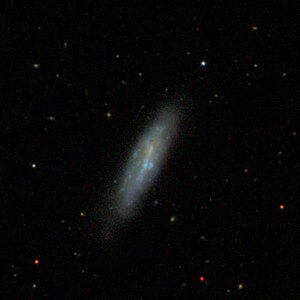NGC 5109
| Galaxy NGC 5109 |
|
|---|---|

|
|
| SDSS recording | |
| AladinLite | |
| Constellation | Big Bear |
|
Position equinox : J2000.0 , epoch : J2000.0 |
|
| Right ascension | 13 h 20 m 52.3 s |
| declination | + 57 ° 38 ′ 41 ″ |
| Appearance | |
| Morphological type | Sbc |
| Brightness (visual) | 12.9 mag |
| Brightness (B-band) | 13.7 mag |
| Angular expansion | 1.7 ′ × 0.5 ′ |
| Position angle | 153 ° |
| Surface brightness | 12.6 mag / arcmin² |
| Physical data | |
| Redshift | 0.007108 ± 0.000030 |
| Radial velocity | 2131 ± 9 km / s |
|
Stroke distance v rad / H 0 |
(100 ± 7) x 10 6 ly (30.7 ± 2.2) Mpc |
| history | |
| discovery | Wilhelm Herschel |
| Discovery date | April 24, 1789 |
| Catalog names | |
| NGC 5109, 5113 • UGC 8393 • PGC 46589 • CGCG 294-032 • MCG + 10-19-061 • IRAS 13189 + 5754 • 2MASX J13205234 + 5738410 • GC 3509, 3512 • H II 826 • III 808 • h 1588 • NSA 163387 | |
NGC 5109 = NGC 5113 is a 12.9 mag bright spiral-shaped Low Surface Brightness Galaxy of the Hubble type Sbc in the constellation Great Bear in the northern sky . It is estimated to be 378 million light years from the Milky Way and about 50,000 light years in diameter. In the same area of the sky is u. a. the galaxy IC 875 .
The object was discovered twice by Wilhelm Herschel with an 18.7-inch reflecting telescope ; first on April 24, 1789 (listed as NGC 5113 ), then on March 17, 1790 with a slightly different sky position (listed as NGC 5109 ). During these observations he noted “F, S, E” and “cF, S, E”; John Herschel described it in 1828 as "vF, pmE, 30sec".
